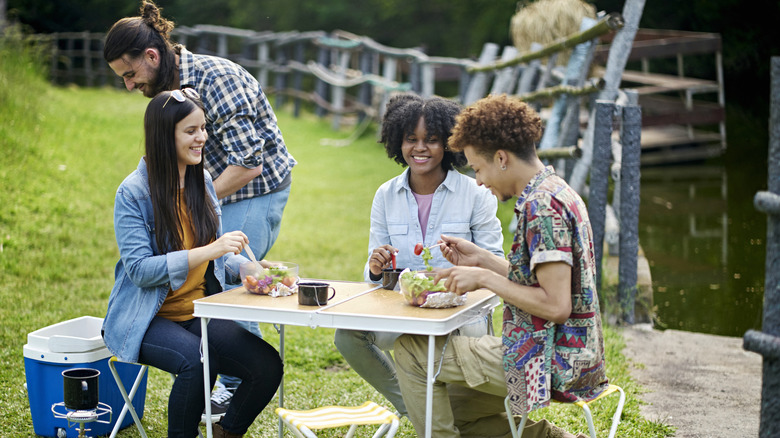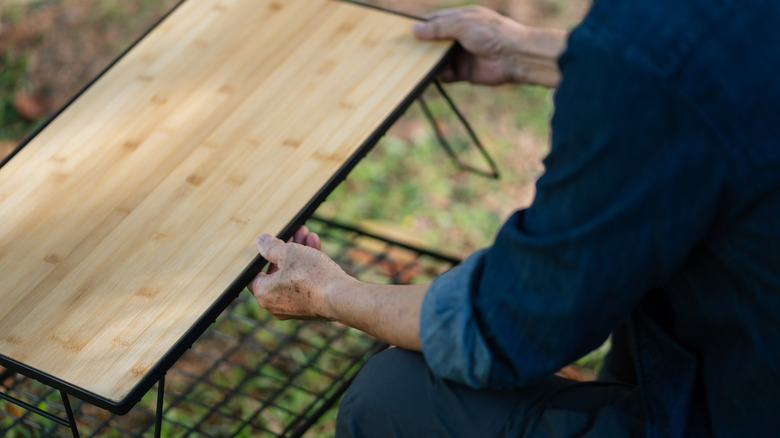Give Your Plastic Folding Tables A Makeover With A DIY Wood Topper
We may receive a commission on purchases made from links.
If you rely on plastic-top folding tables for events, you might hate the look they provide. Whether you buy colorful plastic tablecloths or use a DIY pool noodle hack to change the look of the folding table, it's fun to give this boring piece of furniture a fresh design. If you'd like to make it look more like a wooden table, you can give your plastic folding tables a makeover with a DIY wood topper. TikTok user coastaleventrentals created a farmhouse-style topper out of richly-stained wood that goes over the plastic table top, and it looks amazing. This is similar to what HGTV stars did to hide a pool table in plain sight.
Unfortunately, the TikTok video doesn't give any directions for building the topper. It certainly looks great, but is it something you could do as a DIY project? We decided to reach out to our House Digest expert carpenter and remodeler, Bob Beacham, for some advice about the challenge of this job and whether it's worth trying.
"Is it worth it? Hmm. If you fancy the project and you think it will make a big difference to a folding table that you like using, why not?" Beacham says in an exclusive interview with House Digest. "If it's just to hide the appearance of the tabletop, a tablecloth is a lot easier! Also, if you're going to that effort, why not take it a step further and build a complete outdoor table to the exact size you want — assuming you can leave it out in the yard all year. [That would be a] much more satisfying project."
How to build your own DIY table topper out of wood
Because the TikTok video doesn't have instructions, we asked Beacham what kinds of tools and steps you'd need to take to build this topper. In an exclusive interview with House Digest, he says the best option is using a biscuit joiner with glue to assemble the wood into the topper. The biscuit joiner tool cuts slots into adjacent pieces of wood. You then insert glue and "biscuits," or oval-shaped, thin pieces of wood, into the slots to hold the boards together. (If you need to buy a biscuit joiner tool, you could pay anywhere from $50 to $150.) Use clamps to hold the boards in place until the glue dries. "You could also drill and dowel using a similar technique, though it's slower, and care is needed to be accurate," he says.
Beacham notes that the topper in the video uses butt-joining techniques on the corners, which makes the job easier. "For the best look, the edge pieces should have 45-degree mitered corners," he says, adding, "[But] does it really matter with a bit of 'rustic' furniture like this? You could plane and sand the entire surface level and smooth, but again, does it matter?" After gluing and clamping the boards to finish the top, he says you can apply your favorite finish. Be sure to apply a preservative that's made for exterior use if you plan to use the topper outdoors, Beacham says.
Tips and cost estimates for building a wood table topper to hide a plastic folding table
As for the budget for this project, Beacham says in his exclusive interview with House Digest that the size of the topper will affect the cost. He suggests using 1-by-6-inch pressure-treated lumber for the topper, allowing it to stand up to outdoor exposure. This is a similar type of lumber you'd use to build a deck. Southern yellow pine 1-by-6-inch pressure-treated lumber costs about $5 at Lowe's for a 6-foot board. "If you want cedar or poplar, it's going to be more," he says. "So a 6-by-3-foot table would be $30 plus a bit for the edges." You'd need glue, finishes, and stains, too. If you decide to tackle this project, Beacham says it's important to use a high-quality glue that will work for items used outdoors. His recommendation is Titebond III Wood Glue, which is available for $10 for 16 ounces.
He suggests matching the topper's dimensions to the dimensions of the plastic table. "[It] probably needs to be a reasonable fit to the existing table, or the top will slide around," Beacham says. "You could make it bigger if you add some kind of retaining border underneath, but you'd have to be careful of it toppling over if someone leaned on the edge."
As a final tip, Beacham says it's important to follow safety recommendations. Wear eye protection when cutting wood. Use a mask when applying a finish and only apply it in a well-ventilated area, he says.

